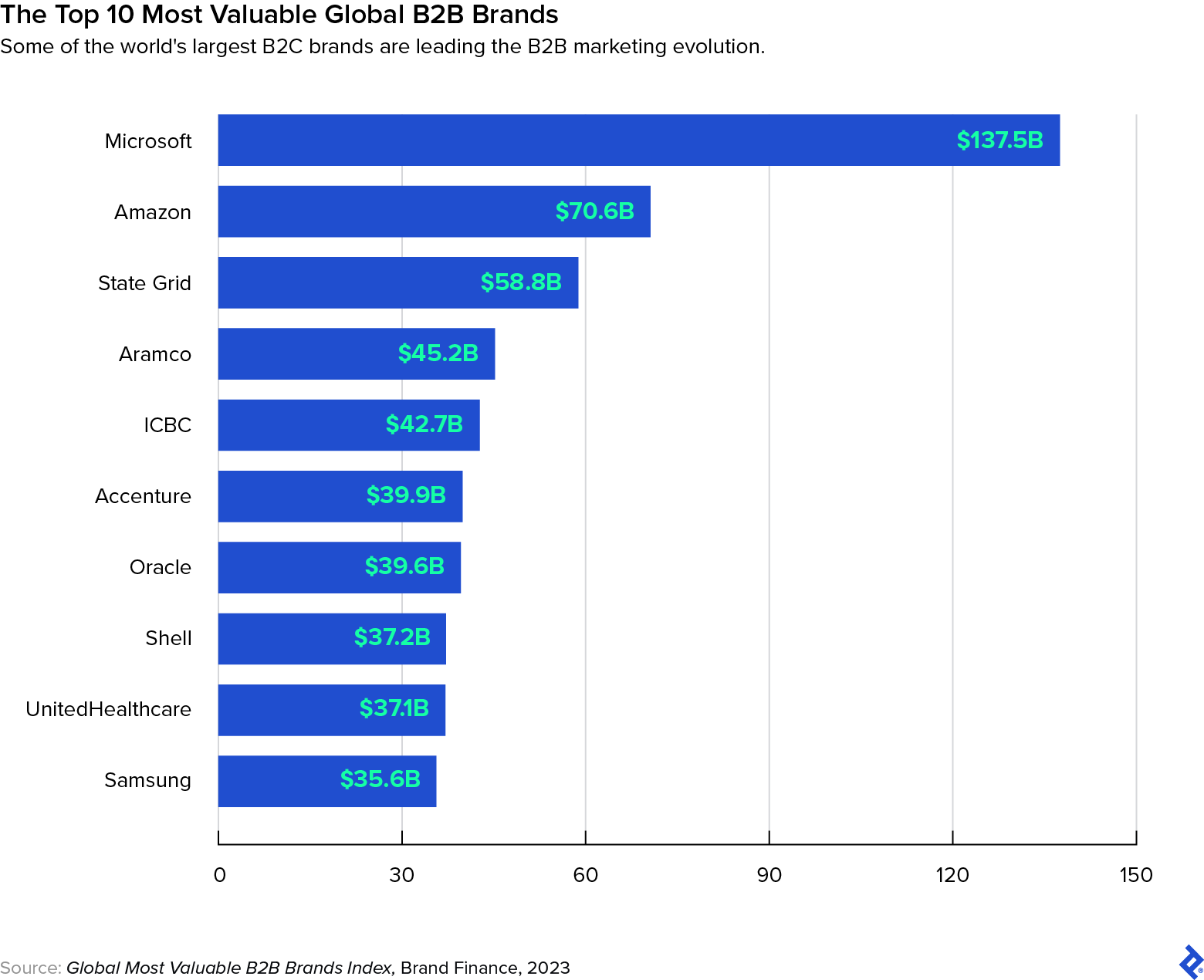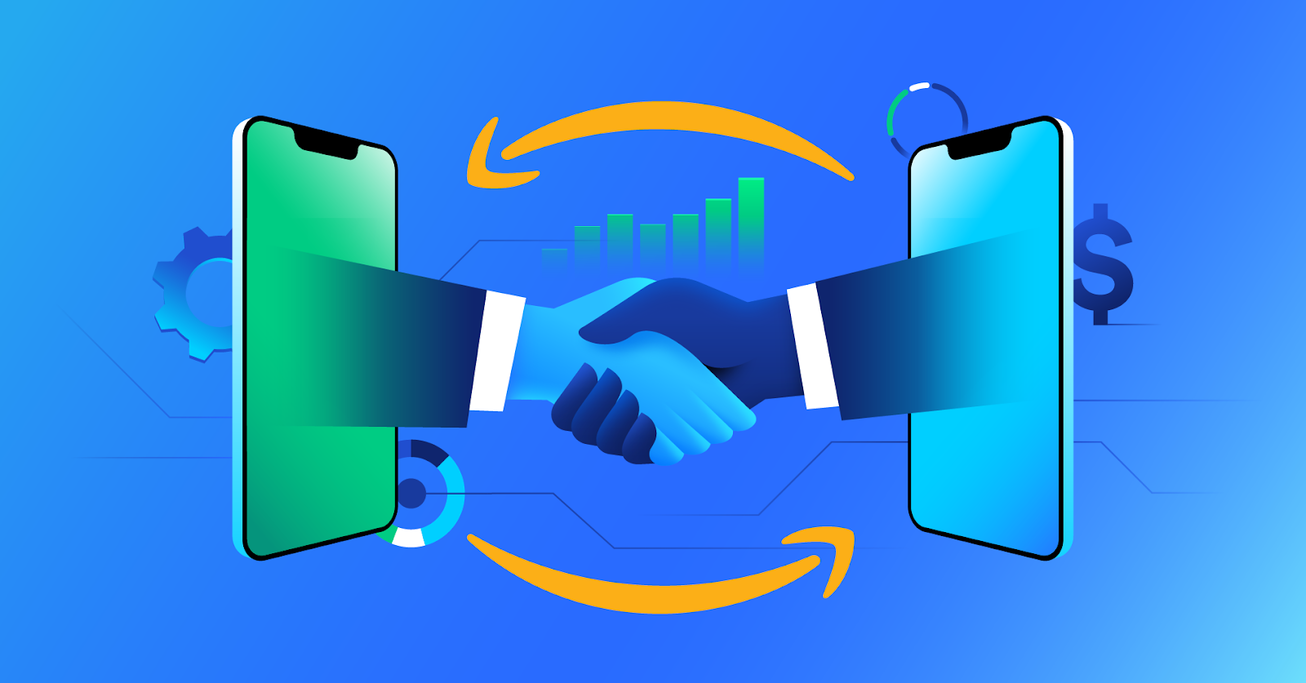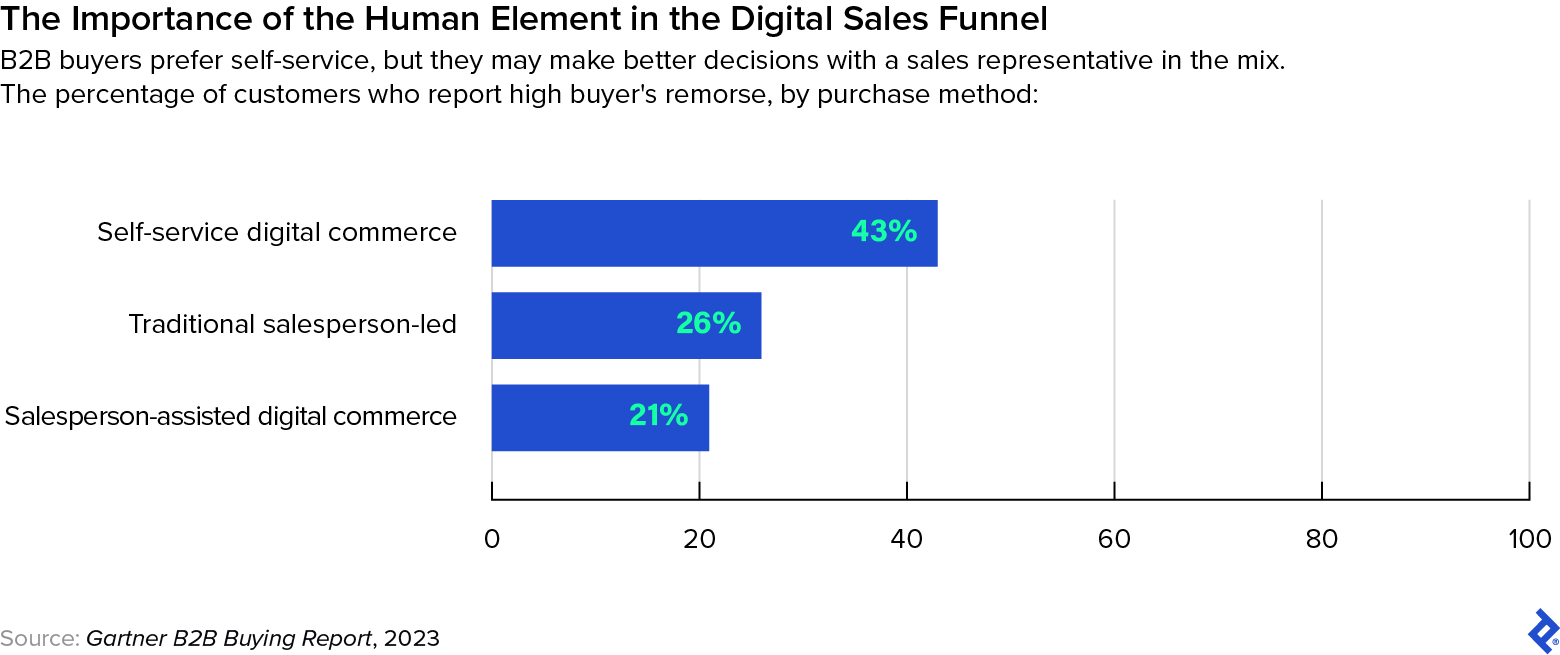The Future of B2B Marketing: Consumerization and the Amazon Effect
Today’s business customers expect sophisticated and personalized buying journeys. Jeff Gangemi, Toptal’s Growth Marketing Practice Lead, explains how firms must leverage robust martech and data-savvy talent to meet the moment.
Today’s business customers expect sophisticated and personalized buying journeys. Jeff Gangemi, Toptal’s Growth Marketing Practice Lead, explains how firms must leverage robust martech and data-savvy talent to meet the moment.
Jeff is the Growth Marketing Practice Lead at Toptal. He holds a bachelor’s degree from Middlebury College and an MBA from Cornell University with an emphasis in leadership and innovation. Jeff has spent the past 15 years building demand generation, content marketing, and digital programs that drive meaningful transformation and growth for both internal teams and external clients. Before joining Toptal, he held senior management roles at Accenture Song, Material, and Telus International.
PREVIOUSLY AT


It was 2018, and I was in the headquarters of a medium-sized B2C advertising and marketing agency in Los Angeles. The founder and CEO was nearly yelling, imploring me to take a contract role with one of his firm’s consumer packaged goods (CPG) clients that was promoting a liquid food alternative. “Get out of B2B. B2B companies don’t do marketing!” He couldn’t have been more wrong.
Although B2B marketing wasn’t as sophisticated as B2C marketing then, it was still demonstrably impactful. At that point, I had personally helped drive millions of dollars in funnel growth, directly attracting some of my companies’ biggest enterprise clients through smart content marketing programs, lead generation, and highly customized account-based marketing (ABM) programs.
Since then, the magnitude and importance of B2B marketing has only grown, and the worlds of B2B and B2C marketing have increasingly converged. Revenue from online B2B transactions in the US was $1.7 trillion at the end of 2021, according to research from Forrester—roughly double that of B2C transactions. Of necessity, B2B marketing has become more and more advanced, demonstrating what marketing experts might call the Amazon effect on B2B marketing. In other words, heightened expectations created by B2C innovators like Amazon—particularly around digital commerce—have carried over into B2B.
Advancements in e-commerce, personalization, the use of data, and marketing technology over the last several years have been significant. In my role as the Growth Marketing Practice Lead at Toptal, I help companies build industry-leading marketing teams that understand and push the envelope on the continuing progression of B2B marketing. In this article, I lay out some of the biggest B2B marketing trends—and ways that your business can leverage them to earn new customers and drive sales.

The Impact of Amazon-style E-commerce on Customer Expectations
Most people think of e-commerce as a way to restock toothpaste, buy birthday presents for friends and family, or order groceries. What may not immediately come to mind are the multimillion-dollar B2B e-commerce transactions for things like SaaS software, cloud services, information technology, medical equipment, and many other business purchases.
These transactions may be made on behalf of businesses, but people are still the ones clicking the “buy now” button. Millennials and Gen Z buyers made some of their first major purchases online. In many cases, these customers rarely utilize traditional brick-and-mortar retail for personal purchases—so why would they choose traditional salesperson-led experiences when they have company dollars to spend?
In fact, they don’t. Most business buyers now actually prefer to transact digitally, even for purchases of $500K and beyond, according to McKinsey—but only with well-developed e-commerce sites. Today, a low-quality B2B e-commerce experience could leave millions of dollars on the table. Such high stakes have helped push demands on B2B marketing teams to a new level.
For B2B marketing leaders, the lesson here is simple. Even if you don’t think your business needs a sophisticated e-commerce platform and experience, your customers likely disagree. Listen to them, and let them transact in the ways they prefer.
The Future of B2B Marketing Is (Mostly) Self-service
As we’ve established, user-friendly customer experiences—made popular not just by e-commerce giants like Amazon, but also by Uber, Netflix, social media platforms, and others—have created higher demands on B2B marketing.
B2B companies need to improve the tools they offer to potential clients; they can no longer rely on sales teams to generate leads and close deals. As Rob Sanchez, CEO of B2B marketing agency Anteriad, wrote in 2023, “Taken together, today’s B2B buyers want more flexibility, more access to information, and more choice across channels. B2B marketers must give buyers what they are looking for and optimize to close sales quickly and profitably.”
Many B2B companies, in SaaS technology and beyond, now provide world-class customer experiences enabled by sophisticated martech stacks and data strategies. DocuSign and Spendesk, among many others, personalize content and experiences by industry. Monday.com enables users to personalize their on-site experience by use case, and that’s before gathering any additional first-party data.
At the same time, many of these marketing teams are dealing with entirely different sets of challenges than B2C. For example, B2B sales cycles are often longer than B2C, so nurturing leads and building consultative relationships while tracking and managing movement through the funnel becomes critical. Even though there are differences between the B2B and B2C experience, customer expectations have converged. Rather than partnering with a salesperson, B2B buyers largely want to move themselves through the purchase journey via self-service.
Today’s B2B marketers must understand this and streamline their sales process—offering but not requiring opportunities for human interaction.
The lessons for marketing leaders: Allow your prospects to educate themselves on your product or service. Build a digital experience that enables prospective buyers to move through the journey at their own speed. Tailor content and digital touchpoints by industry, use case, or funnel stage to provide value higher in the funnel, and shorten that journey without requiring human intervention.
The Importance of Personalization
One way B2B marketers assess the relative value of customer touchpoints is through the development of sophisticated buyer personas; essentially a personification of ideal customer groups. These personas then get translated into personalized, multi-step buying paths, where B2B marketers now use traditionally B2C-focused data analysis to identify the highest-leverage touchpoints.
Why? Because 76% of buyers get frustrated when they don’t get personalized interactions, according to McKinsey. In my experience, that’s true for both B2B and B2C buyers.
Demand for self-service, custom, and personalized experiences helps to explain why a sales and onboarding experience for Salesforce now looks a lot more like a sign-up experience on the Uber consumer app. It’s also why B2B SaaS companies like Snowflake create dynamic content experiences that change based on buyer behavior, such as previous content consumption. To keep up with Amazon-level expectations, B2B marketers will have to ramp up content production to make every touchpoint an opportunity for personalized interaction.
The lesson here is that every touchpoint matters. Today’s prospects and customers may prefer fewer touchpoints, less often. That’s especially true if the chosen interactions enable them to find the content they’re looking for in a way that feels customized or personalized to their needs.
Technology and Data Differences in B2B and B2C Marketing
Building customized, modular content to enable personalized user experiences on websites and across marketing channels is hugely important, but don’t forget content delivery—another area where B2B is drawing closer to B2C. Once a company creates content with dynamic elements like logos and industry information, it then has to orchestrate cross-channel experiences. That requires tech and data infrastructure that can be difficult to integrate and maintain in real time.
My experience with consultancies, startups, SMBs, and enterprise businesses has proven that data is the biggest differentiator today between B2B marketing leaders and laggards.
Over the past few years, more marketing teams have implemented a customer data platform (CDP) or other data management—but most companies still have a long way to go. An overwhelming majority of marketing teams (91%) say direct access to customer data gives them a competitive advantage, according to a 2022 report by the CMO Council. Still, 31% of marketers don’t have a single source of truth for all their marketing data, according to HubSpot—and only about a quarter say their data is fully integrated with the tools they use.
A centralized customer data source like a CDP creates the “golden customer record,” another name for the single source of truth for customer interactions with the brand and teams across all channels. A CDP can create real leverage through integration with other key martech systems. For instance, CDPs often link up with a customer relationship management (CRM) platform like Salesforce, HubSpot, or one of more than 1,500 other CRM systems in the market. Then, a set of platforms that enable automation and orchestration, such as Adobe Marketo, Braze, or hundreds of others, draw on the customer-specific data, enhance and enrich the content, and serve it up across channels.
Centralizing customer data is an important aspiration, but the true value lies in building a more seamless customer experience through a coordinated, connected martech stack. To keep up with such demands, B2B firms must hire data-informed marketers who also “get” the new, tech-driven world of B2B marketing. A leading B2B team today might include omnichannel customer experience designers, performance marketing specialists, content strategists, marketing analytics experts, and conversion rate optimization specialists, alongside teams of data-savvy SEO experts.
The Future of B2B Marketing Is Complete Alignment with Sales
In the B2C world, the entire operation exists to drive consumption and purchase; customer targets are clear, and marketing and sales activity are fundamentally aligned. Campaigns drive visits. Digital conversion paths are rigorously designed and redesigned to optimize conversion rates.
Many B2B purchases have longer, more consultative sales cycles, larger buying groups, and more complicated procurement processes than B2C. Marketing’s job is to use content and technology to generate and qualify leads; then the sales team takes over, closes the purchase, and converts those leads to revenue. This may sound simple, but keeping the customer warm and engaged through a complex handoff process can be challenging.
That’s because leads and customers may or may not be the same people, and sales and marketing often disagree on who to target. On average, there is only 16% overlap between sales and marketing targets, according to recent LinkedIn research—and this misalignment represents wasted effort, missed sales opportunities, and long-term losses in revenue. To continue to make gains on their B2C counterparts, B2B marketers must align their target customer groups with sales.
B2B and B2C marketing still maintain some important differences, and most B2C marketing budgets still dwarf their B2B counterparts, especially for brand-building. There have been exceptions over the years, like IBM and other professional services firms. But very few B2B firms employ A-list actors to advertise at the Super Bowl as Salesforce did, though there is evidence that is also changing.
As B2B marketing has caught up with B2C, the lesson is clear: Gone are the days of the traditional “ad man” from decades past, relying on creativity, gut instinct, and a big budget. Today’s top marketers across B2B and B2C use data to both inform the customer experience and prove marketing ROI, creating sustained growth for the firms that employ them.
Have a question for Jeff or his team? Get in touch.
About the author
Jeff is the Growth Marketing Practice Lead at Toptal. He holds a bachelor’s degree from Middlebury College and an MBA from Cornell University with an emphasis in leadership and innovation. Jeff has spent the past 15 years building demand generation, content marketing, and digital programs that drive meaningful transformation and growth for both internal teams and external clients. Before joining Toptal, he held senior management roles at Accenture Song, Material, and Telus International.
PREVIOUSLY AT








